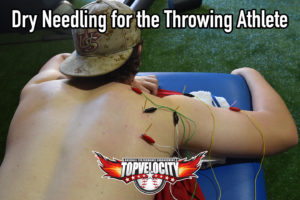 Athletes at all levels put their bodies through incredible amounts of stress and this can often lead to soft tissue injuries. Soft tissue in this case refers to the muscles, ligaments, and tendons that get put to use with every motion we make. As a Physical Therapist, I have found that one of the greatest tools I have to help speed the healing process and return the athlete to their prior performance level is through dry needling. Dry needling is a western medicine concept similar to acupuncture, and studies show that it can have a remarkable impact.
Athletes at all levels put their bodies through incredible amounts of stress and this can often lead to soft tissue injuries. Soft tissue in this case refers to the muscles, ligaments, and tendons that get put to use with every motion we make. As a Physical Therapist, I have found that one of the greatest tools I have to help speed the healing process and return the athlete to their prior performance level is through dry needling. Dry needling is a western medicine concept similar to acupuncture, and studies show that it can have a remarkable impact.
How Does Dry Needling Help
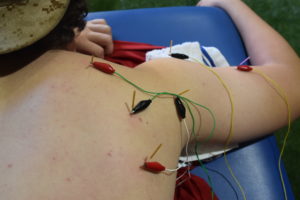 Recently on the show, I was asked about my thoughts on acupuncture for elbow pain. I don’t claim to do acupuncture but rather dry needling, and I think it is an excellent tool that can be used for tendonopathy in the shoulder, elbow, hips, and knees. Several recent studies support the use of dry needling in the management of tendinopathy; more specifically, dry needling has been shown to positively influence tendon healing by increasing blood flow via local vasodilation and collagen proliferation (1). By needling proximal and distal to the injured area, we see an increase in bloodflow to the region improving oxidation and promoting a more efficient healing environment.
Recently on the show, I was asked about my thoughts on acupuncture for elbow pain. I don’t claim to do acupuncture but rather dry needling, and I think it is an excellent tool that can be used for tendonopathy in the shoulder, elbow, hips, and knees. Several recent studies support the use of dry needling in the management of tendinopathy; more specifically, dry needling has been shown to positively influence tendon healing by increasing blood flow via local vasodilation and collagen proliferation (1). By needling proximal and distal to the injured area, we see an increase in bloodflow to the region improving oxidation and promoting a more efficient healing environment.
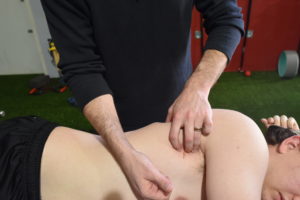 Not only can dry needling help with the healing process but it can improve the muscle firing patterns that are necessary to prevent injury. Lucas et al. found that even in 89.9% of pain free subjects, there were latent trigger points which could result in a change in muscle activation patterns decreasing muscle efficiency. This poor recruitment pattern may lead to premature muscle fatigue altering mechanics and potentially predispose to overuse injuries.
Not only can dry needling help with the healing process but it can improve the muscle firing patterns that are necessary to prevent injury. Lucas et al. found that even in 89.9% of pain free subjects, there were latent trigger points which could result in a change in muscle activation patterns decreasing muscle efficiency. This poor recruitment pattern may lead to premature muscle fatigue altering mechanics and potentially predispose to overuse injuries.
How Are We Using Dry Needling For The Throwing Athlete
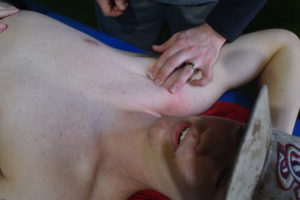 With dry needling we are primarily focusing on the trigger points and spasmodic muscle fiber, but we also treat the tendon and neural tissue as well. Common muscles requiring attention include those composing the posterior cuff do to the heavy eccentric load required to slow the throwing motion. These muscles will tend to get overworked and hypertrophy resulting in a decrease in total range of motion and poor control throughout the follow through phase of the throwing cycle. By needling the muscle belly and the insertion point on the humeral head, we can impact the muscle firing pattern, decrease the static tension of the muscle, and stimulate an increase in bloodflow to the irritated tendon/bone. An overactive Pectoralis Minor in combination with an underactive Serratus Anterior is another force couple commonly contributing to poor biomechanics. This common example of over/under activation can result in an anterior tipping of the shoulder which predisposes an overhead athlete to shoulder impingement. A final location in the shoulder region that is commonly irritated is the Biceps tendon attaching at the superior labrum. This muscle is a decelerator during elbow extension, and repeated motion will place increased strain on the labrum. By treating all of these problem areas, we can improve the mechanical motion of the shoulder through improving firing patterns, decreasing muscle tension, and improving the recovery rate of irritated tissue.
With dry needling we are primarily focusing on the trigger points and spasmodic muscle fiber, but we also treat the tendon and neural tissue as well. Common muscles requiring attention include those composing the posterior cuff do to the heavy eccentric load required to slow the throwing motion. These muscles will tend to get overworked and hypertrophy resulting in a decrease in total range of motion and poor control throughout the follow through phase of the throwing cycle. By needling the muscle belly and the insertion point on the humeral head, we can impact the muscle firing pattern, decrease the static tension of the muscle, and stimulate an increase in bloodflow to the irritated tendon/bone. An overactive Pectoralis Minor in combination with an underactive Serratus Anterior is another force couple commonly contributing to poor biomechanics. This common example of over/under activation can result in an anterior tipping of the shoulder which predisposes an overhead athlete to shoulder impingement. A final location in the shoulder region that is commonly irritated is the Biceps tendon attaching at the superior labrum. This muscle is a decelerator during elbow extension, and repeated motion will place increased strain on the labrum. By treating all of these problem areas, we can improve the mechanical motion of the shoulder through improving firing patterns, decreasing muscle tension, and improving the recovery rate of irritated tissue.
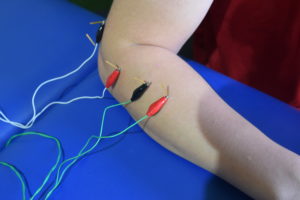 As part of the protecting mechanism for the elbow, the muscles that cross the joint will stabilize in order to decrease the strain on the ligaments. Major muscles involved in the process of protecting the UCL, the ligament(s) involved with Tommy John surgery, include the Pronator Teres, the Flexor Carpi Ulnaris, and the Biceps. In addition, there is a balancing act between concentric muscles such as the Triceps and eccentric muscles, such as the Biceps, that must engage in order to safely complete the throwing cycle along with the Pronator and Supinator muscles. With repetitive movement, any of these muscle can experience symptoms of overuse such as pain, fatigue, and weakness. Another symptom that is commonly reported is tingling into the 4th and 5th digits as part of the distribution of the ulnar nerve. Multiple studies show evidence that peri-neural needling of non-trigger point structures helps reduce pain and disability while improving sensory and motor nerve conduction velocities (1).
As part of the protecting mechanism for the elbow, the muscles that cross the joint will stabilize in order to decrease the strain on the ligaments. Major muscles involved in the process of protecting the UCL, the ligament(s) involved with Tommy John surgery, include the Pronator Teres, the Flexor Carpi Ulnaris, and the Biceps. In addition, there is a balancing act between concentric muscles such as the Triceps and eccentric muscles, such as the Biceps, that must engage in order to safely complete the throwing cycle along with the Pronator and Supinator muscles. With repetitive movement, any of these muscle can experience symptoms of overuse such as pain, fatigue, and weakness. Another symptom that is commonly reported is tingling into the 4th and 5th digits as part of the distribution of the ulnar nerve. Multiple studies show evidence that peri-neural needling of non-trigger point structures helps reduce pain and disability while improving sensory and motor nerve conduction velocities (1).
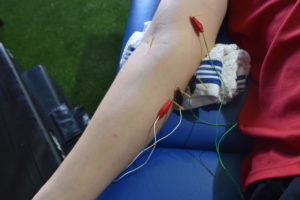 Based on my clinical experience and the abundance of research literature being produced, dry needling is an excellent adjunct to traditional physical therapy. It has been shown to improve blood circulation, stimulate the healing cycle, improve nerve conduction velocity, and improve muscle activation patterns. By promoting healthy tissue and utilizing a total body approach to training, rehabilitation, and biomechanics education, I feel injury risk and rehabilitation times can be significantly improved for the overhead athlete.
Based on my clinical experience and the abundance of research literature being produced, dry needling is an excellent adjunct to traditional physical therapy. It has been shown to improve blood circulation, stimulate the healing cycle, improve nerve conduction velocity, and improve muscle activation patterns. By promoting healthy tissue and utilizing a total body approach to training, rehabilitation, and biomechanics education, I feel injury risk and rehabilitation times can be significantly improved for the overhead athlete.
About the author:
RT is an Orthopedic Clinical Specialist, trained in the diagnosis and management of complex orthopedic conditions for the overhead athlete. A native of Shreveport, Louisiana, he graduated with a degree in Kinesiology from LSU in Baton Rouge. He obtained his Doctorate in Physical Therapy in 2012 from LSU Health Sciences Center in New Orleans and completed an Orthopedic Residency through the University of St. Augustine in 2013. Over the years, RT has worked with both amateur and professional athletes achieving great results using a combination of manual therapy skills and modernized treatment approaches.
References:
- James Dunning, Raymond Butts,Firas Mourad, Ian Young, Sean Flannagan, and Thomas Perreault. Dry needling: a literature review with implications for clinical practice guidelines. Phys Ther Rev. 2014 Aug; 19(4): 252–265
- Lucas KR, Rich PA, Polus BI. Muscle activation patterns in the scapular positioning muscles during loaded scapular plane elevation: the effects of Latent Myofascial Trigger Points. Clin Biomech (Bristol, Avon). 2010 Oct;25(8):765-70.
- V Phadke, PR Camargo, and PM Ludewig. Scapular and rotator cuff muscle activity during arm elevation: A review of normal function and alterations with shoulder impingement. Rev Bras Fisioter. 2009 Feb 1; 13(1): 1–9
- Shane T. Seroyer, MD,* Shane J. Nho, MD, Bernard R. Bach, MD, Charles A. Bush-Joseph, MD, Gregory P. Nicholson, MD, and Anthony A. Romeo, MD. The Kinetic Chain in Overhand Pitching Its Potential Role for Performance Enhancement and Injury Prevention. Sports Health. 2010 Mar; 2(2): 135–146



